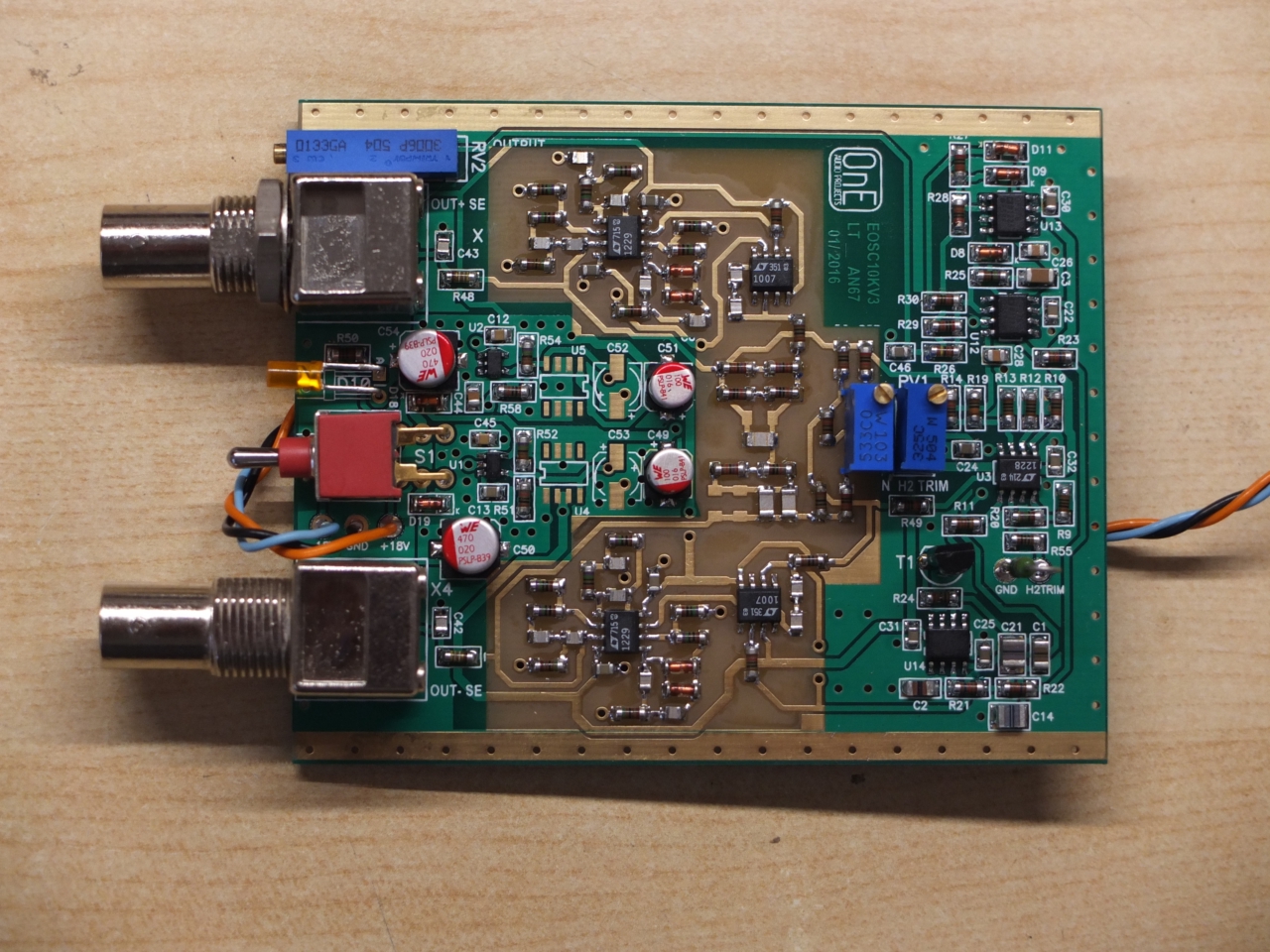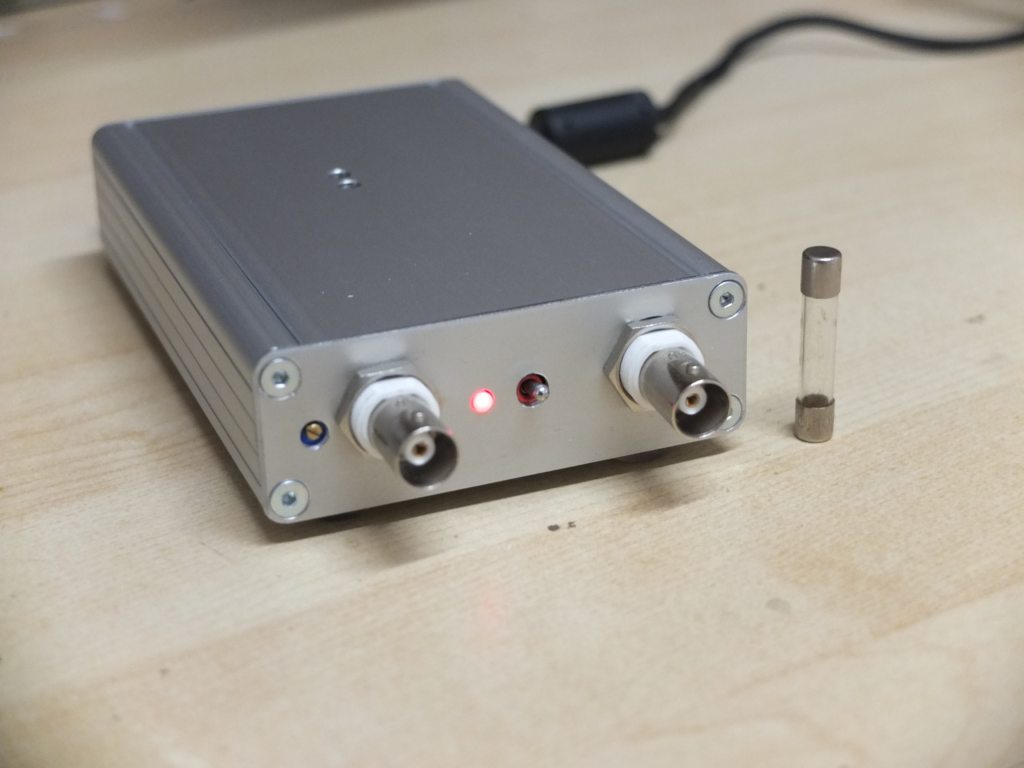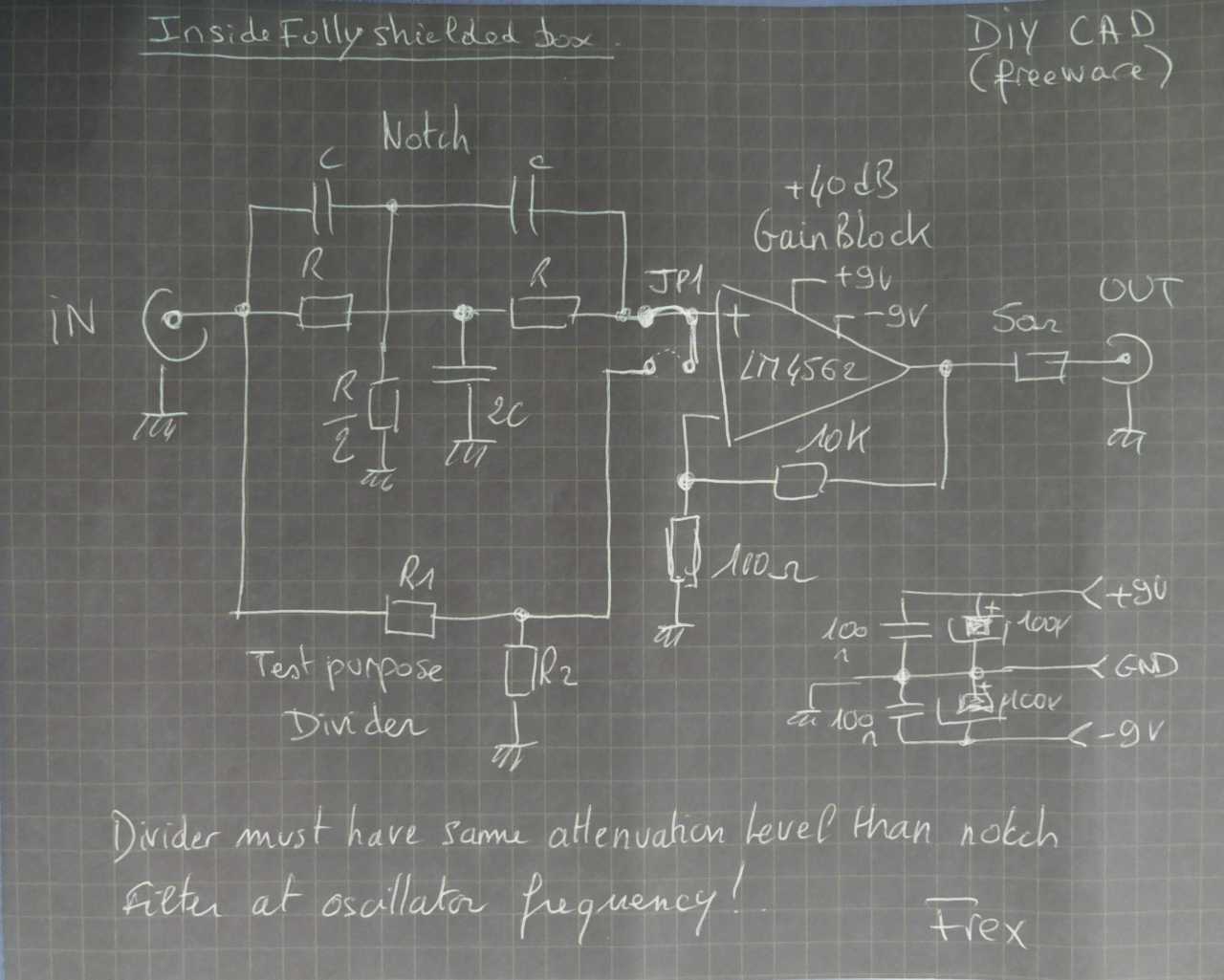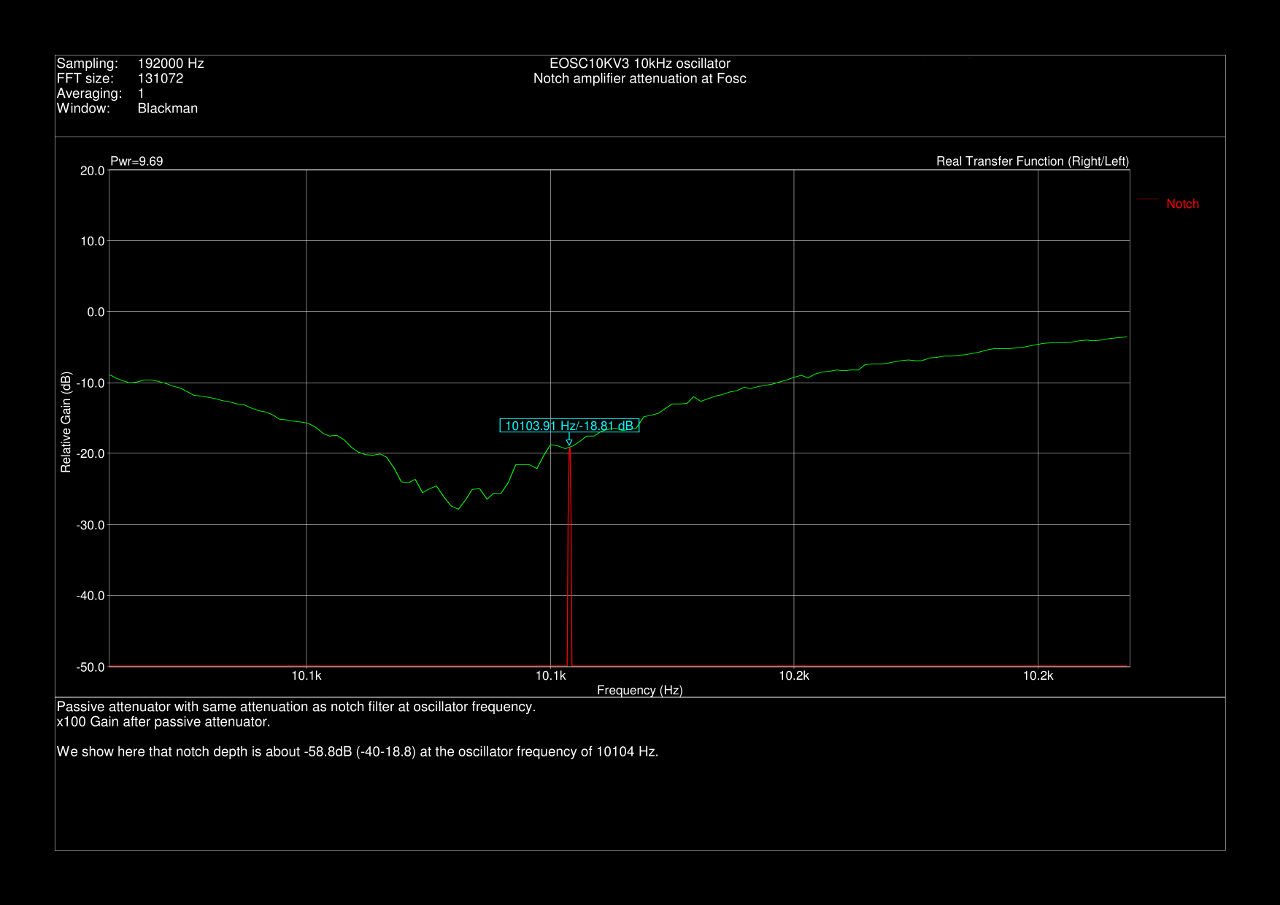Hello all,
Some years ago now, i showed to DIYers in this forum my own build of the
AN67 LinearTech application note high performance ultra-pure sine oscillator.
I used it to check the performance of my EADCAKMv1 ADC project (based on AK5394A).
Many DIYers were interested to get the PC to build it, and so i decided to organize
some group buy to sale this PCB.
Now, i continue to receive request to provide the bare board of this oscillator regularly.
The concern is that the LT1230 become hard to find, or, at prohibitive price.
Thus, i decided to update the design of the oscillator, replacing LT1230
by the easy to find LT1229 and using SMD parts.
Some improvements listed below has been done :
-
I have received the prototype PCB last week, it look like this :
The PCB dimensions are 92x75mm, intended to fit in the small
aluminium enclosure (1455J1201 from Hammond).

After some painstaking soldering work (i like that!), it give a fully populated PCB :

In the Hammond enclosure ..



Of course, now the important thing to do is to test it's real performance !
Measuring a THD below ppm level with some confidence is an hard task.
Many parameters can corrupt results.
So, much care has to be done before choosing measurements method.
The measurement below, show the FFT result of the oscillator output
connected to my EADCAKMv1 ADC through a passive stepped attenuator.
The attenuator was set to -10dB attenuation to find the lowest thd point
of the ADC. (the measured THD come mainly from the ADC itself).
The EOSC10KV3 board is set to 1Vrms at output (single ended).
It is supplied by a +/-16dc linear PSU (Metrix lab PSU).
Photo spectrum

As you can see the spectrum plot is very clean, with all spurious much below -120dBV
and noise floor below -140dBV in the full measured bandwidth.
Here, and without notch filter, the measured THD is 0.00006% (-124.4dBc) !
So, we can assume with confidence that oscillator THD level is then much low this level,
because we reach here probably the lower thd available with any ADC IC !
That confirm the fact (confirmed by JensH and others here) that the AK5394A
is still the best audio ADC available...
(The full test setup is described in spectrum plot)
To finish it, i have to mount the circuit board in it's enclosure.
I will drill it these days.
(all test has been done at free air without enclosure).
I will add pictures with finished design soon.
As my others project, i have done some documents for this updated design,
in order to simplify as much as possible the building task and get a
working oscillator "fingers in the nose".
You can download below the schematics and full bill of material in pdf form :
A good new, now with it's reduced size, the bare PCB price is seriously falling.
Overall BOM cost has been also reduced and all parts are easy to find and
can be ordered using only Mouser and Farnell (or Digikey).
The new PCB price is 18€ outside EU and 17€ inside EU.
The price include shipping, Paypal fees and the complete design folder.
Of course, any DIYers interested to get the PCB can send me PM.
Regards.
Frex
Some years ago now, i showed to DIYers in this forum my own build of the
AN67 LinearTech application note high performance ultra-pure sine oscillator.
I used it to check the performance of my EADCAKMv1 ADC project (based on AK5394A).
Many DIYers were interested to get the PC to build it, and so i decided to organize
some group buy to sale this PCB.
Now, i continue to receive request to provide the bare board of this oscillator regularly.
The concern is that the LT1230 become hard to find, or, at prohibitive price.
Thus, i decided to update the design of the oscillator, replacing LT1230
by the easy to find LT1229 and using SMD parts.
Some improvements listed below has been done :
-
- Much smaller PCB size, mainly SMD parts.
- SPDT toggle switch for power on/off on the front of the PCB.
- Ultra low noise regulators option (LT1761/LT1964)
or standard regulators (LM317L/LM337L). - Output voltage adjustment on front panel from 500mV to 3Vrms.
- Can be supplied with 4x6F22 battery’s.
- Reverse polarity protected.
- Improved low stray capacitance design
- No HF oscillation output behaviour with long coax cable
- Solid ground plane with minimum slot on bottom side.
- Oscillator section use MMA0204 precision low noise
thin film melf resistor and ECHU stacked metallised PPS capacitors) - Fit in low cost Hammond extruded aluminium enclosure.
I have received the prototype PCB last week, it look like this :
The PCB dimensions are 92x75mm, intended to fit in the small
aluminium enclosure (1455J1201 from Hammond).

After some painstaking soldering work (i like that!), it give a fully populated PCB :

In the Hammond enclosure ..



Of course, now the important thing to do is to test it's real performance !
Measuring a THD below ppm level with some confidence is an hard task.
Many parameters can corrupt results.
So, much care has to be done before choosing measurements method.
The measurement below, show the FFT result of the oscillator output
connected to my EADCAKMv1 ADC through a passive stepped attenuator.
The attenuator was set to -10dB attenuation to find the lowest thd point
of the ADC. (the measured THD come mainly from the ADC itself).
The EOSC10KV3 board is set to 1Vrms at output (single ended).
It is supplied by a +/-16dc linear PSU (Metrix lab PSU).
Photo spectrum

As you can see the spectrum plot is very clean, with all spurious much below -120dBV
and noise floor below -140dBV in the full measured bandwidth.
Here, and without notch filter, the measured THD is 0.00006% (-124.4dBc) !
So, we can assume with confidence that oscillator THD level is then much low this level,
because we reach here probably the lower thd available with any ADC IC !
That confirm the fact (confirmed by JensH and others here) that the AK5394A
is still the best audio ADC available...
(The full test setup is described in spectrum plot)
To finish it, i have to mount the circuit board in it's enclosure.
I will drill it these days.
(all test has been done at free air without enclosure).
I will add pictures with finished design soon.
As my others project, i have done some documents for this updated design,
in order to simplify as much as possible the building task and get a
working oscillator "fingers in the nose".
You can download below the schematics and full bill of material in pdf form :
A good new, now with it's reduced size, the bare PCB price is seriously falling.
Overall BOM cost has been also reduced and all parts are easy to find and
can be ordered using only Mouser and Farnell (or Digikey).
The new PCB price is 18€ outside EU and 17€ inside EU.
The price include shipping, Paypal fees and the complete design folder.
Of course, any DIYers interested to get the PCB can send me PM.
Regards.
Frex
Last edited:
Pretty nice performance. I do have a few questions, though:
What's the idea with the opening in the solder mask in the middle of the board? Are you concerned about leakage?
Why the use of MELF resistors rather than, say, 1206? MELF is a royal pain to solder as the resistors tend to roll off the board.
Tom
What's the idea with the opening in the solder mask in the middle of the board? Are you concerned about leakage?
Why the use of MELF resistors rather than, say, 1206? MELF is a royal pain to solder as the resistors tend to roll off the board.
Tom
Hello Tom,
The solder mask has been partially removed to prevent any parasitic capacitance on the high gain/bandwidth block.
These opamps are current-feedback type, and even a low feedback capacitance can cause instability issue and cause HF oscillations.
I've used 0204 type melf resistors because they have the best cost/performance value for thin film resistors.
Of course they can be replaced by 1206 flat type if you are more comfortable with.
Hello Turbon, thanks !
Regards.
Frex
The solder mask has been partially removed to prevent any parasitic capacitance on the high gain/bandwidth block.
These opamps are current-feedback type, and even a low feedback capacitance can cause instability issue and cause HF oscillations.
I've used 0204 type melf resistors because they have the best cost/performance value for thin film resistors.
Of course they can be replaced by 1206 flat type if you are more comfortable with.
Hello Turbon, thanks !
Regards.
Frex
Nice work!
I agree that the distortion measured is probably determined by the ADC. Using a loopback test I measured distortion of around -124dB to -125dB and somewhat lower at a certain level.
Is the capacitance of the solder mask really relevant? It is very thin compared to the PCB substrate.
It would be interesting to see the distortion measured with a good notch filter.
I agree that the distortion measured is probably determined by the ADC. Using a loopback test I measured distortion of around -124dB to -125dB and somewhat lower at a certain level.
Is the capacitance of the solder mask really relevant? It is very thin compared to the PCB substrate.
It would be interesting to see the distortion measured with a good notch filter.
Hello,
I have a notch filter box, but after doing many measurements
I noticed that I show higher H3 level as expected regarding the spectrum plot without notch.
With the notch filter, H3 is slightly less than -120dBV, and H2 inside noise floor (<-145dBV). No others harmonics are visible.
(Surprisingly, if i compare with the EOSC10KV2, the harmonics level are
inverted, H3 is in noise floor and H2 about -126dBV).
I don't understand how H3 can be -126dBV regarding the measurement
without filter
where i can obtain 130dB between fundamental and H3 (Fund=-10dBV,H=-140dBV).
I've done some modification on my notch filter to ensure that it doesn't introduce THD itself,
and it seem to work fine.
Samuel,
It's a good idea, would you be ok if i send you a bare PCB to build it and make some tests ?
(I will of course send it for free).
I need to keep the finished unit to investigate and tried some others things.
I have a notch filter box, but after doing many measurements
I noticed that I show higher H3 level as expected regarding the spectrum plot without notch.
With the notch filter, H3 is slightly less than -120dBV, and H2 inside noise floor (<-145dBV). No others harmonics are visible.
(Surprisingly, if i compare with the EOSC10KV2, the harmonics level are
inverted, H3 is in noise floor and H2 about -126dBV).
I don't understand how H3 can be -126dBV regarding the measurement
without filter
where i can obtain 130dB between fundamental and H3 (Fund=-10dBV,H=-140dBV).
I've done some modification on my notch filter to ensure that it doesn't introduce THD itself,
and it seem to work fine.
Samuel,
It's a good idea, would you be ok if i send you a bare PCB to build it and make some tests ?
(I will of course send it for free).
I need to keep the finished unit to investigate and tried some others things.
Hello,
You are right Chris, PPS needs some care when soldering.
I've not tried COG on the design, but i will do it maybe if i have the time.
From what i've read, PPS and NPO /COG are both very linear (very low THD contribution).
I've done today some others measurements on the oscillator, but with my notch filter,
slightly modified to have better depth at it's frequency.
The output level is set to 0dBm (710mVrms).
Spectrum with notch filter before ADC :

Frex
You are right Chris, PPS needs some care when soldering.
I've not tried COG on the design, but i will do it maybe if i have the time.
From what i've read, PPS and NPO /COG are both very linear (very low THD contribution).
I've done today some others measurements on the oscillator, but with my notch filter,
slightly modified to have better depth at it's frequency.
The output level is set to 0dBm (710mVrms).
Spectrum with notch filter before ADC :

Frex
It's a good idea, would you be ok if I send you a bare PCB to build it and make some tests? (I will of course send it for free). I need to keep the finished unit to investigate and tried some others things.
Thanks very much for your offer! At the moment it is hard for me to find any spare time, and I want to set my priorities on my own oscillator design. So building a unit myself is not feasible. But of course I would return your unit ASAP (shouldn't take more than a few days)--just let me know in case!
Samuel
EOSC10KV3 performance measurements
Hello all,
These days i worked on the oscillator in two ways ;
1 / Wiring a second circuit board using NPO/COG capacitors instead of PPS.
2 / Improving my notch filter box to show more easily spurious below 120dB.
The notch filter box has been modified to add 40dB (x101) gain of the signal at the notch output.
Even with this 40dB gain, the level at the output is enough low to not produce significant THD in the ADC
(Level is about -18dBV, near to be the lowest THD point of ADC).
To verify this, i use a passive divider instead of the notch to check Gain block at same signal level.
The schematics of the notch filter box look like this :

You can also show below some pictures of the box, and how it is connected to ADC input (EADCAKMV1).



You can show the shielded (French chocolate) box that avoid spurious noise coming from anywhere.

The good news is that effectively the NPO capacitors seem to be superior,
i can get lower harmonics level than with PPS type.
First you can show the check spectrum where no significant harmonics are visible.
(Here the oscillator signal through the divider without notch filter)

You must note that the showed spectrum must be translated to -40dB down to give the real level
because of the 40dB gain of the notch box output.
We can see that without the notch filter, the amplifier output noise is very low with all spurious
below 160dBV (-120-40 = -160dBV).
So, we can resolve very low harmonics level with this amplifier, without introducing significant THD.
(Because we will get same level at the ADC input when we fit the notch in signal path).
Now, in the graph below we show the notch filter response (with the 40dB gain) and the oscillator signal.
We verify then that the attenuation of the notch at the oscillator frequency is equal to the attenuation
we have previously tested the signal chain to ensure no THD is introduced by the ADC at this signal level.
The attenuation is -58dB +40dB gain = -18dBV level at ADC input
==> This is well the signal level we have tested previously.

Finally, we can show the measurement result of the new EOSC10KV3 oscillator using NPO/COG capacitors.
The last graph show the notch filter/gain box Bode plot (violet) and the amplified output of the notch
filter.

As we see, all harmonics level are extremely low, below -140dBc (H2) !
The calculated THD using these harmonics levels is about -136.5dB or 0.000015 %
Samuel, i will prepare a unit for send you this week for testing with your high-end setup.
I'll send you PM about that soon.
Frex
Hello all,
These days i worked on the oscillator in two ways ;
1 / Wiring a second circuit board using NPO/COG capacitors instead of PPS.
2 / Improving my notch filter box to show more easily spurious below 120dB.
The notch filter box has been modified to add 40dB (x101) gain of the signal at the notch output.
Even with this 40dB gain, the level at the output is enough low to not produce significant THD in the ADC
(Level is about -18dBV, near to be the lowest THD point of ADC).
To verify this, i use a passive divider instead of the notch to check Gain block at same signal level.
The schematics of the notch filter box look like this :

You can also show below some pictures of the box, and how it is connected to ADC input (EADCAKMV1).



You can show the shielded (French chocolate) box that avoid spurious noise coming from anywhere.

The good news is that effectively the NPO capacitors seem to be superior,
i can get lower harmonics level than with PPS type.
First you can show the check spectrum where no significant harmonics are visible.
(Here the oscillator signal through the divider without notch filter)

You must note that the showed spectrum must be translated to -40dB down to give the real level
because of the 40dB gain of the notch box output.
We can see that without the notch filter, the amplifier output noise is very low with all spurious
below 160dBV (-120-40 = -160dBV).
So, we can resolve very low harmonics level with this amplifier, without introducing significant THD.
(Because we will get same level at the ADC input when we fit the notch in signal path).
Now, in the graph below we show the notch filter response (with the 40dB gain) and the oscillator signal.
We verify then that the attenuation of the notch at the oscillator frequency is equal to the attenuation
we have previously tested the signal chain to ensure no THD is introduced by the ADC at this signal level.
The attenuation is -58dB +40dB gain = -18dBV level at ADC input
==> This is well the signal level we have tested previously.

Finally, we can show the measurement result of the new EOSC10KV3 oscillator using NPO/COG capacitors.
The last graph show the notch filter/gain box Bode plot (violet) and the amplified output of the notch
filter.

As we see, all harmonics level are extremely low, below -140dBc (H2) !
The calculated THD using these harmonics levels is about -136.5dB or 0.000015 %
Samuel, i will prepare a unit for send you this week for testing with your high-end setup.
I'll send you PM about that soon.
Frex
Hello Akhilesh,
First, the oscillator has not been designed to work at 1kHz, so changing frequency could be much work than you expect (I will work soon on the 1kHz version but not ready yet).
I don't provide the Gerber files, but you can buy the bare PCB from me, see first post.
With the bare PCB i provide a very complete design folder to build the oscillator.
Regards.
Frex
First, the oscillator has not been designed to work at 1kHz, so changing frequency could be much work than you expect (I will work soon on the 1kHz version but not ready yet).
I don't provide the Gerber files, but you can buy the bare PCB from me, see first post.
With the bare PCB i provide a very complete design folder to build the oscillator.
Regards.
Frex
Hello Richard,
Why do you think phase shift of the notch filter will change the H2 level ?
I think that FFT show harmonics level regardless of the phase. No ?
(except if others THD products occur after the notch and are in opposite phase...).
Frex
Only because I have seen the notch affect the 2H level with other analyzers and notch filters.
You might change the notch Q and or depth to see if there is any 2H level change. usually, the affects are not an issue on 3H and beyond.
THx-RNMarsh
Ok Richard.
I've done many measurements and i am very confident about their validity.
But of course, when we speak about some hundreds of nanovolts, we must take much care when interpreting ...
So, i have finished my first oscillators with it's enclosure (updated pictures on my first post).
and i am nearly ready to send the unit to Samuel.
I think he could make some serious measurements with it's high-end setup that i can only dream....
Frex
I've done many measurements and i am very confident about their validity.
But of course, when we speak about some hundreds of nanovolts, we must take much care when interpreting ...
So, i have finished my first oscillators with it's enclosure (updated pictures on my first post).
and i am nearly ready to send the unit to Samuel.
I think he could make some serious measurements with it's high-end setup that i can only dream....
Frex
- Home
- Design & Build
- Equipment & Tools
- EOSC10Kv3 - LT AN67 10kHz oscillator : new updated version !